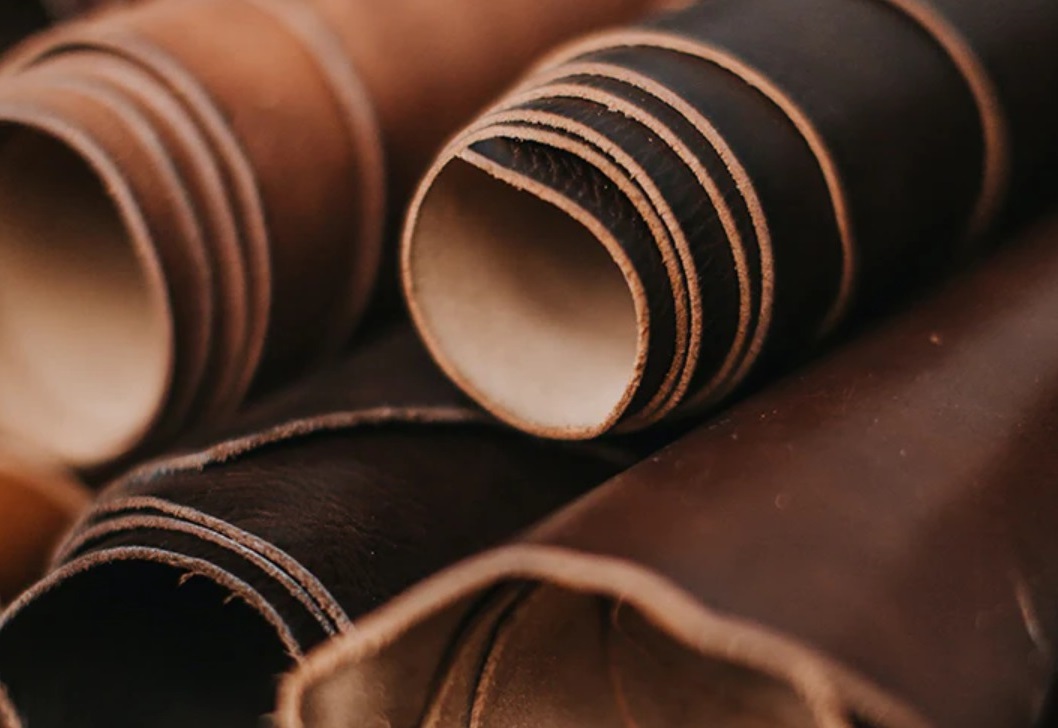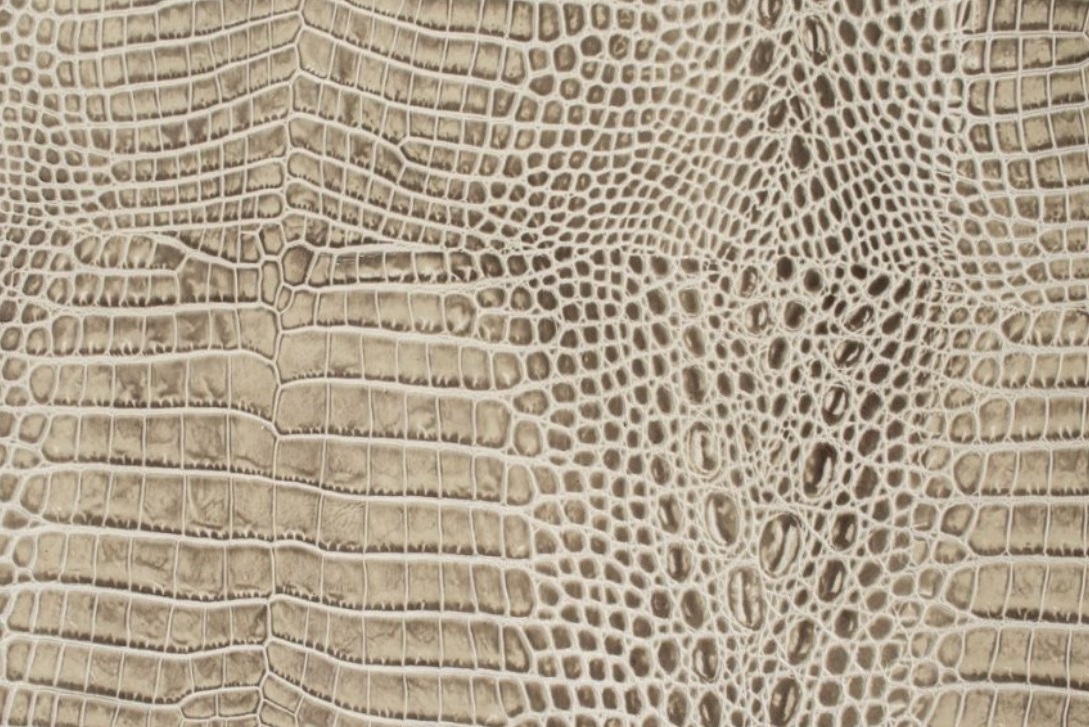There are numerous exceptional varieties of leather accessible. Each type has its own distinct characteristics that can be beneficial for different types of projects or work styles.
Available types of leather include full grain, top grain, genuine, bicast, and bonded. Leather finishes comprise aniline, semi-aniline, brush-colored, degrained, die-cut, embossed, embroidered, handworked, metallic, nappa, nubuck, oily, patent, pigmented, printed, split, suede, and waxy.
Selecting the appropriate leather for your project is critical to achieving a satisfactory outcome. Let’s become acquainted with all the diverse types.
Types of Leather
Various categories can be used to classify types of leather. These can include types of cuts, leather qualities, leather grades, leather finishes, types of leather by animal, types of leather with fur, and even types of faux and vegan leather.
There are significant differences between them, and these differences can be attributed to the manufacturing process, finishing process, type of animal hide, and method of leather cutting. Each of these will be examined in greater detail.
5 Types of Leather
Many individuals are particularly interested in the 5 types of leather. Generally, they are referring to the volume and layers of the original hide that are preserved in the final product. These types are full grain, top grain, genuine, split grain, and bonded leather, and detailed information about each will be provided.
The quality and characteristics of the material can vary depending on the part of the hide from which the finished leather originates. Leather quality can also be influenced by several factors such as the breed of the animal, the climate in which they lived, their diet, and the level of physical activity. Because hides are a natural material, they are greatly affected by the lives of the animals from which they are obtained.
Leather quality can additionally be impacted by the processes used in meatpacking, tanning, and finishing during production. Along with the leather grades familiar to consumers, we will also examine the leather grades used by tanners when assessing hides from meatpackers.
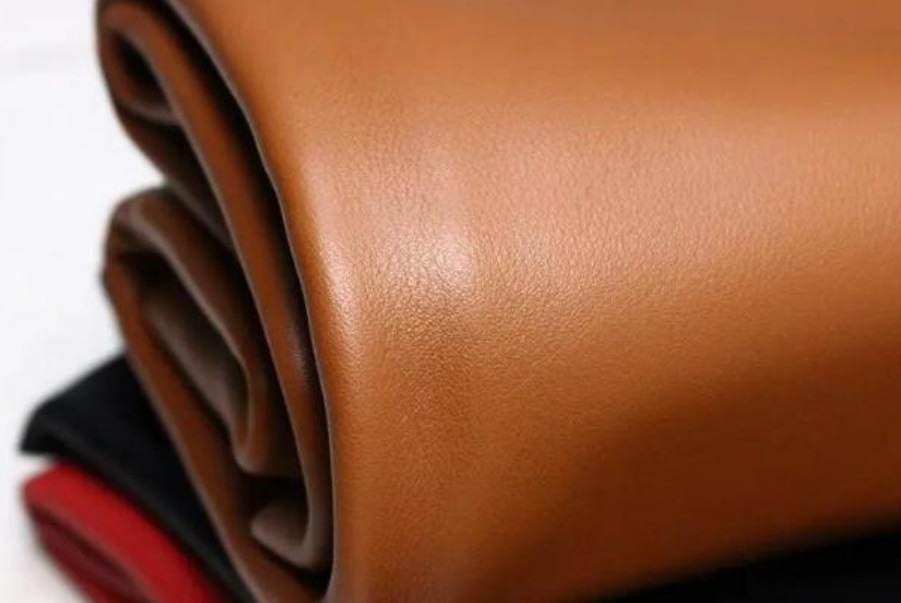
What is a Leather Hide?
A leather hide is the skin that has been removed from an animal. As a natural material, it possesses distinctive characteristics and qualities that enable it to serve a purpose for the animal it was a part of.
It typically forms a protective barrier, safeguarding the animal’s internal parts. Together with hair or fur, it provides protection from external elements such as sun, water, abrasions, and other daily environmental factors. The layers of a leather hide are depicted in a cross-section image.
It consists of a few layers:
Leather Hide – The Grain
The grain refers to the outermost surface of the leather hide, consisting of tight, dense fibers. This layer was exposed to the elements (air, rain, sun, etc.) and is typically very strong and smooth once the hair is removed.
Using grain leather from the outer layers of the hide allows products to retain some of the original qualities of the hide. As a result, every piece of grain leather is distinct, showing the unique features and background of the animal hide.
Leather Hide – The Grain and Corium Connection
The grain and corium junction is the area where the tight outer layer of the leather transitions into the looser fibers of the corium. This junction comprises both the highly desirable grain layer and the more fibrous and looser fibers of the corium layer.
Leather Hide – Corium
The corium is a layer within animal hides primarily composed of collagen fibers. These fibers are less tight and more exposed than those in the grain layer, yet this layer is very suitable for leather production. The corium is typically the thickest layer within an animal hide, so after splitting a hide, parts of the corium may be present in either top grain or genuine leather products.
Leather Hide – Flesh
The flesh comprises mainly muscle and fatty tissues in the hide. It is relatively less valuable for making leather products. Typically, the hide is split to remove the layers above the flesh, resulting in different grades and qualities of usable material for leather production.
When considering leather grades and quality, it is important to understand the preparation, cutting, and finishing processes. Let’s explore the most common methods.
Types of Leather Grades and Qualities
These are the most widespread ways in which leather is graded. The names primarily describe how the leather has been split and the surface treated, rather than actual grades. However, these variations do affect the performance and overall quality of the leather.
Hence, people commonly refer to them as leather grades. Later, we’ll delve into the actual grades used by meatpackers when evaluating hides for sale to tanneries.
Here is an excellent overview of some popular leather types:
Full Grain Leather
This type of leather includes the outer layer of the hide, known as the grain, and has not been sanded or buffed to remove any imperfections. Typically, only the hair is removed from full grain leathers. The grain usually has densely packed, finer fibers, resulting in a very strong, durable surface that can withstand tough use.
Since full grain leather undergoes no sanding, the surface may have minor imperfections caused by everyday activities, such as where a cow may have received a small cut, rubs against a fence, or scrapes. Full grain hides with fewer blemishes are highly sought after, as they are less common and visually appealing.
These surface fibers also make it the strongest type of leather, suitable for saddles, footwear, and furniture. As the outer layer is not removed, it develops a patina over time, which can be visually pleasing. The outer layer also offers some water-resistant qualities. Full Grain is regarded as the finest quality leather that is obtainable.

Top Grain Leather
Top grain leather is very similar to full grain, except it has had the very top layer sanded and/or buffed to remove imperfections and irregularities in the finish. When this method is used, top grain leather becomes softer and more flexible, and it is treated with different dyes and finishes.
While the sanding enhances its visual appeal, it also reduces some of the strength and water-repellent qualities of full grain leather. Thus, we start to see a tradeoff between leather strength and its visual appeal and softness.
Due to its softness and flexibility, top grain leather is often used in high-end leather goods, including handbags, wallets, and shoes.
Genuine Leather (Corrected Leather)
Genuine leather is a broad term for any leather made from animal hides. It can come from any layer of the hide and undergoes treatment to provide a more uniform, “corrected” appearance. Genuine leather can undergo sanding or buffing to eliminate surface imperfections. It can then be dyed, spray painted, or stamped/embossed to achieve the desired surface appearance.
The process alters some of the preferred qualities of leather; thus, while not top quality, it is often used for items such as belts, wallets, bags, gloves, and shoes.
Split Grain Leather
split grain leather is a layered cut of leather from the lower levels within the top grain area of the hide. It comes from a lower layer of the hide above the flesh, but below the full grain and the best top grain cuts. Although it is less dense and tight compared to full grain and top grain, it still provides useful leather material.
The natural surface of split grain leather is less dense, tight, and useful than that of full grain and top grain. Hence, it is often used in colored and embossed leather finishes, altering the surface in significant ways. This allows it to provide some useful leather qualities while having a visually pleasing and often functional surface beneficial for leather products.
Bonded Leather (Reconstituted Leather)
Bonded leather resembles scrapple or hot dogs in the leather world as it is composed of finely shredded leather scraps bonded together with polyurethane or latex onto a fiber mesh or sheet.
The percentage of leather in the mixture can vary significantly, from 10% to 90%, impacting the functional and aesthetic properties of the final product. Often, bonded leather is painted for color and may also be pressed or embossed to simulate a particular grain or leather style.
Recycled Leather
Recycled leather, also referred to as reconstituted leather or upcycled leather, is created from leather scraps, fibers, or remnants collected from various leather manufacturing processes.
These scraps are ground up, mixed with a binding agent, and shaped into sheets or rolls. The durability of recycled leather can be influenced by the quality of the scraps used and the binding agent. The production of recycled leather reduces waste and minimizes the environmental impact of leather manufacturing.
Different leather grades are available for raw hides.
When meatpackers produce raw hides, they immediately grade them to determine their quality and facilitate precise sales to tanneries, which will tan the hides to produce finished leather.
Understanding the qualities of the leather they receive is crucial for tanneries to consistently produce high-quality finished leathers for leather goods production.
When grading raw hides, inspectors examine for issues such as holes, deep cuts, scars, large abrasions, discolorations, machine damage from skinning machines, remaining hair, and grain inconsistencies.
It’s important to note that many large ranch operations brand their cattle to denote ownership. Branding involves using a heated metal brand to burn a unique pattern into the animal’s skin. The impact of branding on hide quality is also considered in the grading process.
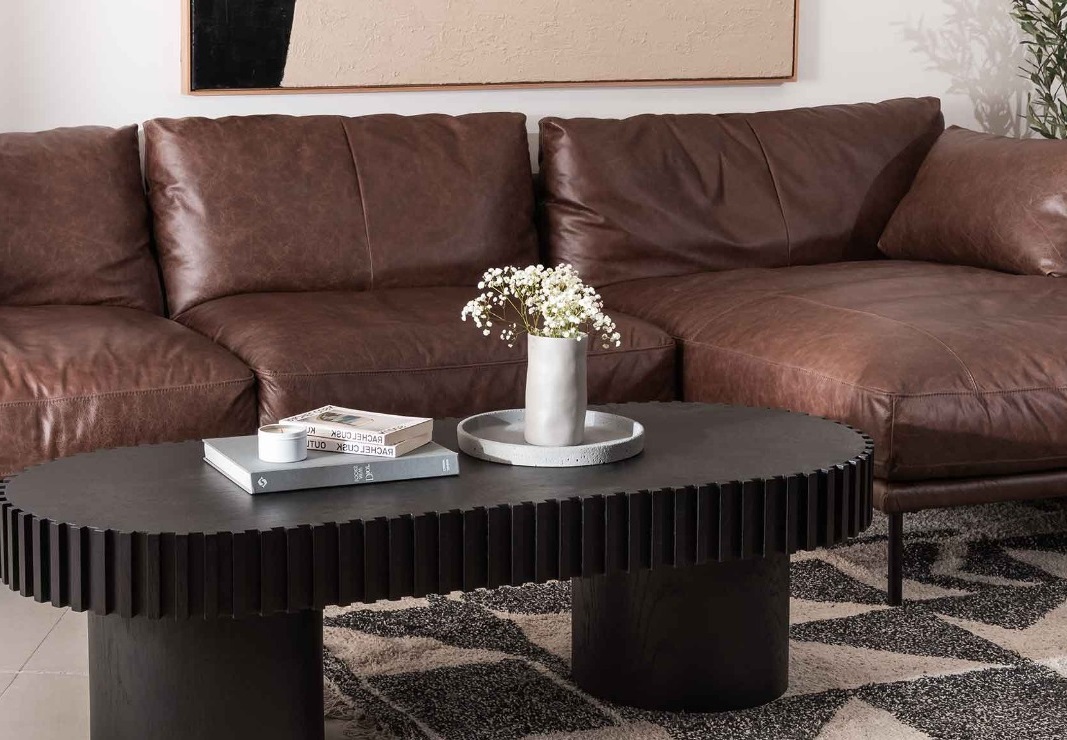
Leather Hide Grade – Number One
Number one hides are top-grade hides, typically free of major surface imperfections, holes, or cuts. If there are holes approximately 3-4 inches from the edge of the hides that can be trimmed away, they won’t affect the overall grade. Around 80% of hides shipped to tanners should be of number one grade.
Leather Hide Grade – Number Two
Number two hides are permitted to have up to four holes or cuts, as long as they are in a generally straight line on the hide, allowing them to be trimmed around later, still yielding a sizable area of usable hide.
Holes should generally be less than 5” to be considered acceptable within a number two grade hide. The size of grain defects should not exceed approximately 1 square foot. Around 15%-20% of hides sent to tanners are classified as a number two hide grade.
Leather Hide Grade – Number Three
Number three hides typically have five or more holes or large cuts within the hide, ideally in a generally straight line, allowing them to be cut around later, still yielding a sizable area of usable hide.
A single cut or hole over 6” can be allowed. There may also be grain defects or a cluster of small holes located closely together, covering an area larger than 1 square foot. Generally, number three graded hides should yield at least 50% usable surface area.
Tanners typically only buy number three-grade hides when they have explicitly agreed to do so.
Leather Hide Grade – Untannable
Hides that do not meet the quality standards for grades one, two, or three are deemed untannable. These hides are not sent to tanners and are utilized in other ways outside of the leather industry.
Tanning Methods
Leather Chrome Tanning
Chromium salts, primarily chromium sulfate, are used to tan chrome tanned leather. This method is known for its efficiency and speed in producing soft, supple leather and is widely used. Compared to vegetable-tanned leather, chrome tanning typically results in leather that is more uniform in color and texture.
Vegetable Tanned Leather
This type of leather is made using natural materials and is also known as veg-tan or tanned leather. Typically, it involves using tannins derived from plants and bark, which are natural astringents.
Types of Leather Cuts
Leather hides offer various areas to choose from when deciding where to cut pieces for a project. Some pieces will be of higher quality and easier to work with based on the area of the hide in relation to the animal’s body.
A finished leather hide usually allows for purchasing based on the cut type, including the full hide or specific areas within it. Knowing the different available cuts can be helpful based on the type of project and desired performance characteristics.
A leather buying guide can provide information on where to get leather cuts or pieces for a project, the different types of leather, leather qualities and grades, thicknesses and weights, common uses for various types of leather, types of cuts and sizes available, cost considerations, tips for selecting the right leather, and recommendations on where to buy leather.
Whole Leather Cut
This encompasses the entire skinned and tanned hide of an animal, including softer areas with various stretch characteristics to thicker, stiffer areas.
Side Leather Cut
This is half of an entire hide, cut lengthwise along the middle, and also includes softer areas with various stretch characteristics to thicker, stiffer areas.
Shoulder Leather Cut
This comes from the shoulder area of the animals and generally has a firm yet malleable and flexible feel, making shoulder cuts good for tooling.
Double Shoulder Leather Cut
This comes from the shoulder area of the animals and is essentially the entire shoulder area from the hide, usually having a firm but flexible and pliable texture.
Bend Leather Cut
This comes from the area ranging from the spine towards the belly towards the middle of the hide, some of the best leather available in a hide, best used across a number of leather product applications.
Double Bend Leather Cut
This comes from the area extending from the spine towards the belly in the middle of the hide, containing some of the best leather available, ideal for a variety of leather product applications.

Butt Leather Cut
This leather is sourced from the hind leg section of the hide, encompassing the buttocks and extending towards the spine, which is the thickest and most robust part of the hide, making it well-suited for thicker items such as heavy belts.
The double butt cut of a leather hide is derived from the hind leg portion of the hide, encircling the buttocks and moving upward towards the spine on both sides of the hide. This section is the thickest and most solid part of the hide. Leather from the buttocks cut is well-suited for making thicker items, such as heavy belts.
The belly cut of a leather hide is taken from the left or right edges of the hide. Animals’ bellies naturally expand and contract as they ingest food and water. This makes belly leather a little softer and more stretchy compared to other areas of the hide. Although not considered top-quality leather, belly cut leather can be used for various leather working purposes.
The double belly cut of a leather hide is obtained from the left and right edges of the hide. Belly leather is relatively softer and more pliable compared to other parts of the hide, as animals’ bellies naturally expand and contract while consuming food and water. Although not considered prime leather, belly cut leather can be used for many different leather working applications.
Leather can be produced from the hide of any animal. Across time, regions, and methods, many different leathers have been produced throughout history.
The most common types today are from cows, sheep, goats, and pigs. However, most any type can be obtained if needed for a project. Let’s discuss some of the more and less common types of leather.
In general, when referring to animal leathers, those from larger animals like cattle are called “hides”, while those from smaller animals such as rabbits or pigs are referred to as skins. Additionally, in terms of quantity, cattle leather accounts for approximately 67% of the total annual leather production worldwide.
Bulls are uncastrated male cattle known for their higher testosterone levels and thick, heavy hides. Bull leather is suitable for thicker leather uses such as heavy belts, show items, and boot soles. There are fewer male cattle kept as bulls for breeding, so smaller quantities of bull leather are typically available compared to other types.
Steers are castrated male cattle and are one of the most popular types of animal leather. There are also many more steers kept compared to bulls, making steer leather more widely available. It works well for leather applications including saddlery, belts, some shoes, and other strap items.
Cows are female bovines that have given birth to calves. They are very common and popular. Cowhide leather is produced from the hide of a cow. Due to its durability and versatility, it is one of the most commonly used types of leather in various products.
Cowhide leather and hair-on cowhide leather, which is cow and other bovine leather that retains its fur, can be used to create a wide range of items, including furniture, clothing, handbags, shoes, and accessories. It is renowned for its natural grain pattern, durability, and resistance to abrasion, making it suitable for both functional and ornamental uses.
Heifers are cows of the female gender that have not yet delivered a calf. This type of leather is generally soft and pliable, making it great for shoes, boots, and other similar leather applications.
Dairy cows are female cattle bred primarily for milk production. Their hides are typically soft and thin, valued for their smooth texture and flexibility, making them perfect for creating comfortable and versatile leather products, including lighter belts and wallets, clothing, upholstery, and straps.
Calves are young male or female cattle. Their hides are generally very soft, thin, and supple, making them useful for finer leather applications such as wallets, watchbands, and smaller leather accessories, including handbags.
Although thinner than cow leather, pig leather provides a durable and wear-resistant material due to its dense fibers. It is also porous, soft, and flexible. Pig leather is predominantly produced in China and is primarily used in clothing because of its breathability and lightness. Pig leather makes up about 10% of the total leather production worldwide.
Sheep
Sheep leather, also known as sheepskin, is popular because it often features one side as leather and the other covered in wool. The wool naturally draws sweat away from the wearer, making it ideal for year-round use in seat upholstery, shoes, slippers, boots, and moccasins. About 12% of the total leather production worldwide comes from sheep leather, including lamb leather.
Lamb
Lambskin leather is a luxurious, high-quality leather made from the hides of young sheep. It is valued for its smooth texture, softness, and lightweight properties, making it a popular choice for fashion items and accessories. Being delicate, it should be handled with care.
Goat
Goat leather is highly soft, durable, and strong. It is often used in manufacturing shoes, boots, gloves, rugs, and bags. The skins are flexible and supple, providing a comfortable feel. Approximately 11% of the total leather production worldwide comes from goat and kid (young goat) leather.
Horse
Horse leather is commonly associated with premium “cordovan” leather, typically made from the butt section of horses. Cordovan leather is very dense, smooth, and thick, making it excellent for fine shoes and gloves. Due to the relatively small surface area of horse butts compared to cattle hides, cordovan leather is usually used for small items such as shoes, gloves, and small accessories.
Exotic Animal Leathers
As leather can be obtained from any animal, a variety of leather types are available and are often referred to as “exotic” leathers due to their rarity and sometimes challenging procurement and manufacture. Some examples of exotic leathers include:
Alligator
Alligator leather, obtained from alligators, particularly the American alligator, is available in various colors and finishes and is recognized for its luxurious appearance and durability. It is commonly used in fashion and accessories, such as handbags, jackets, briefcases, suitcases, watch straps, belts, wallets, bracelets, and footwear.
Beaver Tail
Beaver tail leather is the processed hide of a beaver’s tail, displaying a unique scaly pattern similar to fish or snake skin. Typically, beaver tail leather pieces are small, generally under 1 square foot, and vary in thickness across the tail.
Buffalo leather
Buffalo leather, also known as bison leather, is derived from the hide of American bison and is valued for its rugged appearance, strength, and durability. It is thicker and more resistant to tearing compared to cowhide, making it suitable for heavy-duty applications such as motorcycle jackets, work boots, and upholstery. Its natural grain patterns add character to leather goods.
Crocodile Leather
Crocodile leather is an exotic leather known for its unique pattern, soft texture, durability, and limited production, making it highly sought-after in luxury markets. It is exceptionally durable and wear-resistant, contributing to its long lifespan.
Elk Leather
Elk leather, made from the hide of elks, is known for its strength, softness, and durability and is often used for making gloves, shoes, and other luxury leather goods.
Fish Leather
Fish leather features a distinctive texture with a scale pattern that varies depending on the fish species. Despite being thinner than traditional leather, it is surprisingly strong and durable, valued for its unique appearance, sustainability, and durability.
Kangaroo Leather
Kangaroo leather, made from kangaroo skins, is often used in high-quality sports equipment such as soccer cleats, rugby boots, and gloves, as well as in luxury goods like wallets and belts.
Kangaroo leather is recognized for its strength, lightweight feel, and durability and is highly valued for its distinctive combination of softness and toughness, making it a preferred material in certain types of leathercraft.
Kudu leather is an exotic leather acquired from the skin of the kudu, a large antelope indigenous to southern and eastern Africa. Highly prized for its unique aesthetic and functional properties, it includes a distinct grain pattern, durability, and softness. Kudu leather is resilient, strong, malleable, and supple, similar to goat leather.
Llama leather is sourced from llamas, domesticated animals native to South America. It is cherished for its softness and sleek texture, along with its airy nature. Llama leather is a highly enduring material frequently utilized in the production of high-quality leather goods such as belts, shoes, bags, clothing, jackets, and coats.
Ostrich leather is a type of exotic leather produced from the hide of ostriches and is reputed for its unique texture, durability, and opulent appearance. The material is durable and supple, making it an excellent choice for items such as wallets, watch straps, shoes, bags, and boots.
Peccary leather is derived from the peccary, a species of wild pig native to the Americas. It is highly esteemed for its softness, durability, and distinctive grain pattern Peccaries can be found in South America and some parts of North America, and their leather is renowned for its superior softness and fineness compared to traditional pig leather. Peccary leather is often utilized in high-end leather articles such as gloves, belts, and wallets owing to its luxurious feel and durability.
Stingray leather is an exotic leather obtained from the skin of stingrays. Recognized for its unique round bumps and durability, this leather can be difficult to work with. The hard calcium nodules are exceptionally tough, resembling human teeth, and were traditionally utilized as armor by the samurai. Due to its unique texture and durability, stingray leather is used in the creation of a variety of items, primarily in the fashion and accessory industries.
Yak leather is a thick and heavy material made from the hide of yaks, which are large bovine animals native to the Himalayan and Tibetan regions of Asia. It is primarily used for goods that require strong, tough leather that lasts long and resists abrasions, including clothing, belts, shoes, boots, straps, bags, saddlery, tack, and harnesses.
Certain animals possess valuable fur as part of their hide, which is utilized in creating clothing and accessories with a double face type of leather finishing, featuring one face as finished leather and the other as animal fur. Here is a non-inclusive list of leathers used for furs: Beaver, Chinchilla, Coyote, Fox, Lynx, Mink, Muskrat, Opossum, Rabbit, Raccoon, Sable, Seal, Wolf.
When leathers are produced, they can be finished in numerous different ways. These procedures yield leathers that can be used for a variety of different purposes. Variations can include texture, flexibility, color, and finish. Let’s explore some of the main types of finished leather.
Aniline leather is dyed using soluble dyes, allowing the natural surface of the leather to be visible, including blemishes and cuts. Generally, only higher quality leathers are utilized since they have nice, even surfaces. Aniline leather is then finished with a thin protective coating to help prevent rapid wear of the leather or any other staining or discoloration from showing up on the surface. This dyeing method is visually appealing as it showcases the original surface of the leather.
Semi-aniline leather is a type of leather dyed only with soluble dyes. Similar to aniline leather, semi-aniline leather is minimally pigmented. Semi-aniline leathers permit the natural surface of the leather to show through (blemishes, cuts, etc.). It is then finished with a thin protective coating to help prevent rapid wear of the leather or any other staining or discoloration from showing up on the surface. It is typically made from high-quality leathers with even surfaces, allowing the original surface to show through.
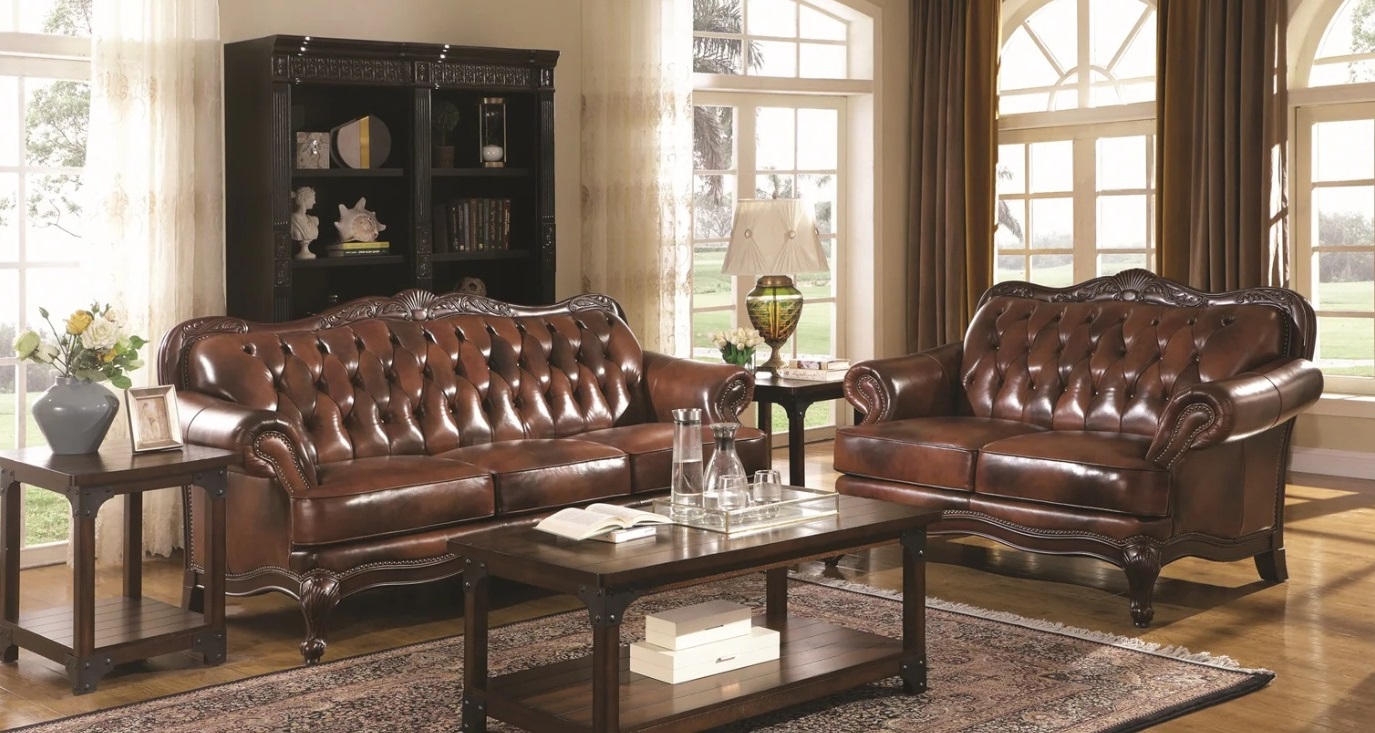
Antique Grain Leather
Antique grain leather is a type of leather that has undergone a treatment to create an aged and worn appearance on the surface. This treatment may involve the application of multiple finishes or a rubbed pattern to imitate the effect of natural wear over time. The use of antique grain leather allows for the creation of a weathered look in the final product without requiring the leather to be genuinely old or worn out.
Bicast Leather
Bicast leather is a type of leather made with a split leather backing and a layer of polyurethane or vinyl that is embossed or impressed on the top. This gives the leather a patterned or shiny appearance without the expense of using genuine top or full grain leather. Bicast leather typically ranges in price from $1 to $5 per square foot, which makes it a compelling choice for budget-conscious leather enthusiasts..
Brush Colored Leather
Brush colored leather is a type of leather where pigment is applied using a brush, resulting in a unique color pattern on each piece. Variations in bicast leather can be seen in gradient, blending, or overall tone. Brush colored leather is suitable for finished pieces seeking a distinctive and creative visual appeal.
Chap Leather
Chap leather is a type of chrome-tanned leather known for its durability, flexibility, and lightweight nature. It is often found in the largest available hides and is typically used for making items such as chaps or other large-scale projects, making it a suitable choice for outdoor and equestrian gear. Chap leather is utilized for creating hard-wearing items that need to withstand wear and environmental damage.
Corinthian Leather
Corinthian leather is a term that gained popularity in the 1970s and 1980s through a series of television commercials for Chrysler luxury vehicles. It was used to describe the upholstery material used in these cars, implying luxurious and high-quality leather.
However, Corinthian Leather is more of a marketing concept than a specific type of leather. It generally refers to a high-grade, soft leather often associated with luxury vehicles.
Crossgrain Leather
Crossgrain leather is a corrected grain leather type that features a noticeable diagonal pattern. This involves the sanding or cutting of heavy, defective hides that are unsuitable for standard tanning methods to create a smooth surface for embossing. This technique creates a uniform leather surface with a protective coating, ensuring durability and resistance to wear.
Debossed Leather
Debossed leather is produced by tooling, stamping, or creasing to leave a recessed impression on its surface. This can be done using an arbor press machine or manually with a mallet and stamping tool.
Debossing, whether on leather or any other material, involves using moisture, heat, or compression force. It’s often used for adding logos, patterns, or textural elements to leather goods like wallets, belts, or book covers.
Degrained Leather
Degrained leather is a type of leather that has had the grain layer removed, usually towards the end of the production process. The benefits of degrained leather include a smooth, consistent surface that looks quite appealing. However, the removal of the grain also weakens the outer surface of the layer, making it more susceptible to wear and moisture penetration.
Distressed Leather
Distressed leather is artificially treated to achieve an aged or worn appearance, deliberately made to look weathered and worn out, often with color and texture variations to imitate natural wear over time.
Distressed leather typically has a rugged, vintage look with a weathered appearance, and may feature natural marks, scars, and wrinkles or have these added artificially to enhance the aged look.
Double Face Leather (Double Sided Leather)
Double face leather, also known as double-sided leather, is a type of leather with two uniquely finished sides. Examples include sheepskins, where one side is finished leather, and the other is wool. Another example is leather that may have different embossed surfaces, one on each side. It could also relate to color, with each side having a unique color or variation of colors.
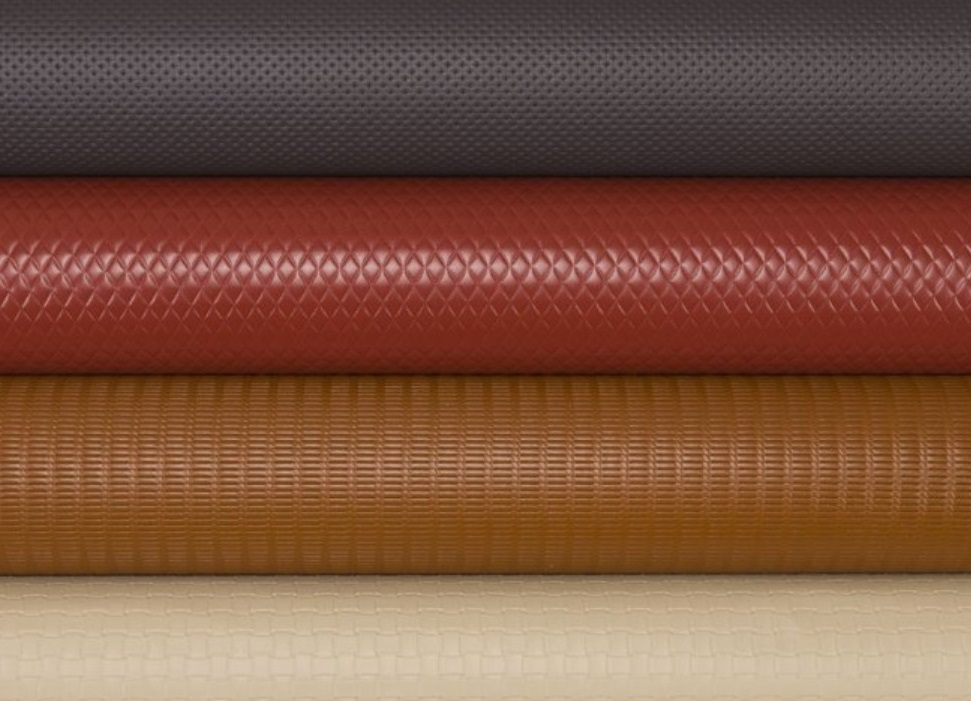
Embossed Leather
Embossed leather entails creating raised patterns on the finished hide. This can be done by: Stamping, Pressing, Rolling, Molding, Forming
Embossed leather is made from different types of leather and is utilized in various applications such as upholstery, fashion accessories, and bookbinding. It can feature designs, lettering, or other visual enhancements on the surface, providing a cost-effective way to mimic exotic leathers like crocodile, deer, or ostrich.
Embroidered leather is a type of leather on which embroidery is applied using needle and thread, creating a decorative pattern or motif for visual or aesthetic appeal.
Epi leather, commonly used in Louis Vuitton bags, is characterized by a raised, cross-grain pattern achieved by stamping the pattern into dyed veg tanned leather and finishing it with a protective coating.
Faux leather, typically made of polyurethane or vinyl, imitates real leather at a lower cost. Its applications include furniture and it is valued for being inexpensive, durable, and easy to clean, although it lacks some authentic leather qualities.
Handworked Leather is created through manual application of leather tools, resulting in tooled, stamped, etched, or embossed surfaces, showcasing the artistry of hand working leather.
Horween leather, produced by the renowned Horween Leather Company, is known for its high quality, durability, smooth texture, and rich color due to the use of traditional techniques.
Interwoven Leather is created by braiding leather together, often used in belts or straps to create a unique textured look.
Italian leather, known for its softness, flexibility, and durability, is produced in Italy and is considered a premium product due to its high quality and traditional production methods.
Latigo leather, known for its water resistance and versatility, is created through a dual chrome and vegetable tanning process, suitable for various projects such as dog collars, bags, and saddlery.
Metallic leather has a metal layer added during the finishing process, resulting in a shiny, reflective look, often used in clothing, accessories, and handbags.
Napa leather, a soft, smooth, full-grain leather, can be dyed in various colors and finished to enhance its water and abrasion resistance.
Nubuck leather, a top-grain leather with a soft, velvet-like surface created by sanding, offers a pleasing touch and unique visual appearance.
Nubuck leather is commonly dyed using soluble dyes that penetrate the fibers, giving them color without changing the surface. It is frequently utilized in leather products, such as jackets, shoes, gloves, bags, belts, wallets, book covers, furniture, watchbands, and accessories.
Oil Leather, also known as pull-up leather, waxy leather, and waxed leather, is a type of leather that contains a higher than usual amount of oils and waxes in the surface finish. When the leather is flexed and moved, the surface reflects light in various ways due to the oils and waxes, resulting in a varied look across surface tones. This unique patina enhances the character of each item as it lightens with use.
Patent leather is a type of leather with a high-gloss finish applied through a coating, typically linseed oil. It was invented in 1818 by Seth Boyden in Newark, New Jersey. The patent leather finish is often very noticeable with a highly reflective appearance. More modern patent leather uses a plastic coating finish instead of the traditional linseed oil. Due to its glossy finish, patent leather is frequently used for formal and dressy leather items such as shoes, handbags, belts, wallets, and fashion accessories.
Pearlized leather has a liquid layer of color added to the surface during finishing, providing a soft, subtle shine and reflection. While not as reflective as metallic leather, pearlized leather is a subtler form of the same concept and is commonly used in clothing, accessories, and handbags.
Pebbled leather, also known as pebble leather, refers to leather with a specific textured surface created by pressing the surface with small, rounded, raised areas or bumps, resembling tiny pebbles grouped together. The texture of pebbled leather is often pleasant and is frequently manufactured in soft natural leathers, as well as in faux and vegan leathers.
Perforated leather is leather punctured with small holes or perforations in a regular pattern, typically done to enhance breathability and reduce heat buildup, making it a popular choice for car seats, sports apparel, and certain types of footwear. The perforations serve a dual purpose, adding a decorative element to the leather while also providing functionality.
Pigmented leather is finished with a top coat of pigment or paint, providing an even surface and a protective coating. It is often coated with a clear protective sealer to help safeguard the pigment layer.
Printed leather has the surface texture printed or stamped into it, creating various leather surface types that serve both functional and aesthetic purposes. Functional purposes include making the leather surface more scratch and abrasion-resistant, while aesthetic purposes include giving it a uniformly pebbled or nubbed appearance. The textures of printed leathers can also have a preferable feel.
Quilon leather is a distinct smooth leather finished with a “hair cell” pattern, which gives the surface a stylish appearance. Developed in 2007 by the Doc Martens footwear company, quilon leather is based on the now-vintage Doc Marten leather from the 1970s.
Saffiano leather, an example of printed leather, is textured and treated with a cross-hatch pattern pressed into the wax coating, making it highly durable, water-resistant, and easy to clean. Due to its elegant appearance and resilience to scratches and stains, saffiano leather is commonly used in luxury goods such as handbags, wallets, and belts.
Soft Leather
Soft leather signifies any flexible hide that may have a velvety feel when touched. It can originate from any animal and be cured using any type of tannin. Popular choices for producing soft leather include chromium-tanned leather, suede, and leather from young animals. Because of its flexibility and comfort, soft leather is an excellent option for creating items such as shoes, bags, gloves, jackets, and clothing.
Stretch Leather
Stretch Leather is a type of leather usually composed of leather that can stretch when utilized. It may utilize a processed leather surface combined with a synthetic underlayer that allows the material to stretch while retaining a uniform appearance and most typical performance qualities. Leather that stretches is frequently used in clothes and leather products designed to be worn and moved in.
Studded Leather
Studded leather refers to leather that has metal studs or spikes incorporated into it, typically for decorative or functional purposes. Historically, it was used in armor and protective gear to offer additional protection against cuts and blows. Studded leather can come in various forms, including jackets, belts, boots, and handbags.
Suede Leather
Suede is a type of leather created using a similar method to Nubuck, where the surface is sanded to leave a slight nap of short protein fibers. Rather than being made from full grain leather, suede is made from split grain leather and is often dyed in various colors.
Tooling Leather
Tooling leather is a type of vegetable-tanned leather specifically designed for carving, stamping, and embossing designs onto its surface. Usually made from cowhide, it has a smooth, firm texture that allows it to hold intricate designs well. Tooling leather is commonly used to create decorative patterns, images, and textures on items such as belts, handbags, boots, notebook covers, watch straps, saddles, and wallets.
Vachetta Leather
Vachetta leather is known for its natural appearance and light color. It is typically tanned using vegetable tanning methods, giving it a pale tan or light beige color. Vachetta leather is commonly found in high-end purses and accessories, especially in the embellishments and straps of these items. Over time, vachetta leather develops a patina, darkening and acquiring a unique character with use and exposure to natural elements.
Vegan Leather
Vegan leather describes materials designed to mimic natural leather but are not derived from animal hides. Typically made from polyurethane (PU) or polyvinyl plastic (vinyl), advancements in technology have led to a wide range of vegan leathers sourced entirely from natural materials such as apple, cork, grapes, kombucha, leaves, mushrooms, and pineapple.
Washable Leather
Washable Leather is better suited to cleaning. While leather should not be roughly cleaned often, special leather washing methods are available. For items that require frequent cleaning, such as some clothes, washable leather can be used to help ensure the items last longer and stay in great shape.
White Leather
White leather is chrome tanned and then whitened or aluminum tanned without dyes added. It may be created from different animal hides, including cowhide, sheepskin, or goatskin. White leather has a clean and elegant appearance, with a smooth and often glossy surface, making it suitable for uses such as clothing, shoes, upholstery, handbags, and accessories.
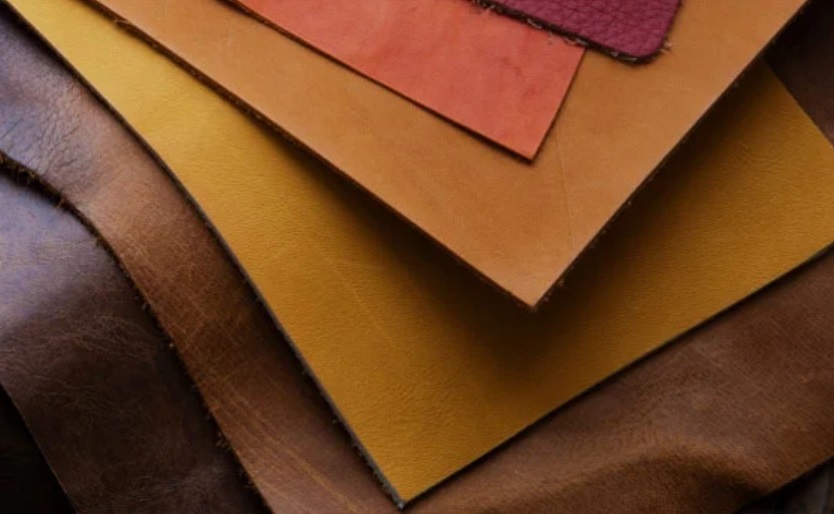
Related Questions:
What is the best leather?
The best leather is generally full grain leather. This type of leather is sleek, solid, supple, and ages gracefully. However, the best leather depends on the type of project it will be used for and personal preference in leather characteristics.
What is the strongest type of leather?
The strongest leather is generally full grain leather, as it hasn’t been sanded or buffed to remove imperfections. The grain has densely packed fibers that are finer, resulting in a surface that is strong, durable, and can withstand tough use.
Conclusion
There are many types of leather available for various needs. You can choose the right leather type for your projects by referring to a guide to leather thickness and weights. Whether for a specific project or your preference for leather qualities, you’ll likely find a great leather to create incredible leather goods. Leatherworking combines practicality with craftsmanship, making it a rewarding and valuable skill or career for those interested in working with their hands and creating enduring products.
